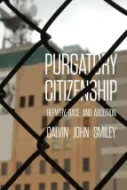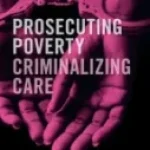Purgatory Citizenship: Reentry, Race, and Abolition
 Author: Calvin John Smiley
Author: Calvin John Smiley
Publisher: University of California Press, 2023. 240 pages.
Reviewer: Colleen Eren | September 2023
In Purgatory Citizenship: Reentry, Race, and Abolition, sociologist Calvin John Smiley provides a critical criminological, avowedly abolitionist and anti-capitalist, ethnographic intervention into the mainstream social science research on the issue of reentry into society following incarceration.[1] Bucking the mainstream’s tendency to focus on quantitative research that relies on reductionist metrics and assessing outcomes like the likelihood to recidivate, Smiley focuses on providing and contextualizing the lived experiences of clients at a reentry center in Newark in the early 2010s and exposing the continued violence, both literal and figurative, of the carceral apparatus on these individuals and their communities. Steeped in the voices of the reentry center’s clients, the book joins a very limited number of other works, such as Bruce Western’s Homeward: Life in the Year After Prison (2018), that foreground those most affected by mass incarceration through their own narratives. It is a necessary intervention that is readable, engaging, and human.[2]
Purgatory Citizenship’s is rooted in Smiley’s doctoral fieldwork while a group leader/educator at a downtown Newark reentry center, in the interviews, focus groups, and observations made there from 2010-2013. Its central arguments revolve around his highly useful/descriptive concept of ‘purgatory citizenship,’ which he defines as ‘how criminal conviction and post imprisonment legal status is altered as individuals are neither fully integrated nor expelled…but rather pushed further to the margins without the ability to have a voice or agency, limiting access to power…and creating a cyclical perpetual punishment”.[3] He teases out how this purgatory citizenship affects the lives of the clients, their communities and families by focusing on a range of discrete topics. These topics include: the ‘purgatory’ halfway house facilities characterized by chaotic environments, lack of sufficient and meaningful programming, violence, stress, and a Kafkaesque continuation of carceral rules and contradictions; the literal disenfranchisement of formerly incarcerated people from the democratic process, which Smiley notes hails back to the post-Civil War attempts to keep Black people from full participation in U.S. society; the impact of incarceration and post-incarceration on health, the body, and mind; the relationship of the clients to space and place, and the relationship of clients to their families and communities.
The concept of purgatory citizenship was particularly compelling because reentry, from a critical perspective, is often discussed as entirely about exclusion. But what Smiley adds to this is theoretical nuance. Yes, the challenges and ‘hidden punishments’ of reentry are about exclusion, but reentry has the additional cruel psychological paradox of being in a state of limbo, as Smiley describes. It is neither freedom nor total exclusion. Even the term ‘halfway’ house illustrates this paradox. Theoretically, it is reminiscent of and connected to Jock Young’s concept of the bulimia of neoliberal society, which absorbs marginalized people in its culture, but at the same time, rejects and excludes them systematically from full belonging.[4]
Among the other valuable insights Smiley provides, I’d like to highlight three. The first is Smiley’s pointing out that the word ‘reentry’ assumes that individuals have, in the first place, ‘entered’ in a substantive sense into a society that has kept them in a state of deprivation. As he makes evident and ties to the work of Walter Rodney, this often is not a reality because of the underdevelopment of the communities from which many of the reentry center clients come.[5] Early entry into the carceral system all but means that the process of reentry will also entail a process of entry itself, for example, making up for not having an employment history, not having state identification, not having graduated high school, and so forth.
Second, Smiley documents in rich detail how reentry necessarily entails a kind of performativity on the part of clients, what he calls “doing reentry.” Because it is performative, for the sake of ‘earning’ of life that is free of carceral supervision and detention, there is a lot of ritualized behavior that clients find meaningless (such as participation in many mandated group sessions), exploitative (as he points out the pecuniary relationship between corporate reentry and the state), or even self-defeating, such as following rules that ultimately reduce chances of success (like refraining from using social media).
Last, and relatedly, Smiley brilliantly shows how the reentry clients use the reentry center as a safe space but also as a place where they can counterintuitively do the rule-breaking necessary for ‘successful’ integration. He writes, “clients engag[e] in risk behavior to remain free…they must engage in deviance to do reentry, undermining mainstream notions of desistance to retain their freedom.”[6] Among the examples he gives are the clients’ using ‘forbidden’ cell phones at the reentry center and the computer lab to access social media, allowing them to reconnect with family and secure jobs through their networks.
Smiley gives a passionate and humanistic argument in the closing chapter that ties in his discussions with the reentry center’s clients during his group sessions about abolition (of all carceral systems: police, courts, and corrections). He combines this with a general history of the abolition movement and its general precepts, with his own belief in its necessity, alongside the abolition of capitalism, which he presents as part-and-parcel of carcel logics.
Among the areas that could have seen more strengthening in the book was Purgatory Citizenship’s sustained theoretical engagement with one or several theories/ theorists. There are many references to scholarship that ties into the observations made through the book. Still, they often are made in a sentence in passing, as a single citation, and not traced throughout the book and in arguments. And so, grounding the text more deeply in a more limited number of concepts or perspectives, I think, would have allowed the reader to trace those ideas through the issues he presents. Second, the book is focused on the racialized experience of those reentering, but it could have more substantively given the experiences of other racialized groups, particularly Latinos and Indigenous people. Some attention is given to Latinos, but no unique history of their criminalization/exclusion, and only the lightest of references are made to crimmigration. Last, the critique of the prison industrial complex and the reentry industrial complex left untouched the nonprofit industrial complex and the way it, too, is enmeshed in the continuation of the carceral state, which given that the location of the study was in a non-profit, could have presented yet another paradox within a paradoxical system.
Overall Smiley has made a notable contribution to the reentry literature, one that gives the reader a vivid, microcosmic snapshot of one reentry space and the individuals there finding/refinding their place in society, which can be seen as emblematic of the much larger picture taking place nationally. It situates reentry within the racialized and class-based criminal legal system and its history. It involves, rather than speaks on behalf of, the individuals impacted by that system. And it gives a humanistic plea for imagining alternatives. It should be of great interest to scholars and students in sociology, criminology, legal and justice studies, those who work within the nonprofit and government sector, and the justice impacted.
Bibliography:
Bruce Western. 2018. Homeward: Life in the Year After Prison. Russell Sage Foundation.
Jock Young. 2007. The Vertigo of Late Modernity, London: Sage.
Colleen Eren is a Professor at William Paterson University.
[1] Calvin John Smiley, Purgatory Citizenship: Reentry, Race and Abolition (2023).
[2] Bruce Western, Homeward: Life in the Year After (2018).
[3] Id. At 7.
[4] Jock Young, The Vertigo of Late Modernity 25 (2007).
[5] Smiley, supra note 1, at 20.
[6] Id. at 127.


